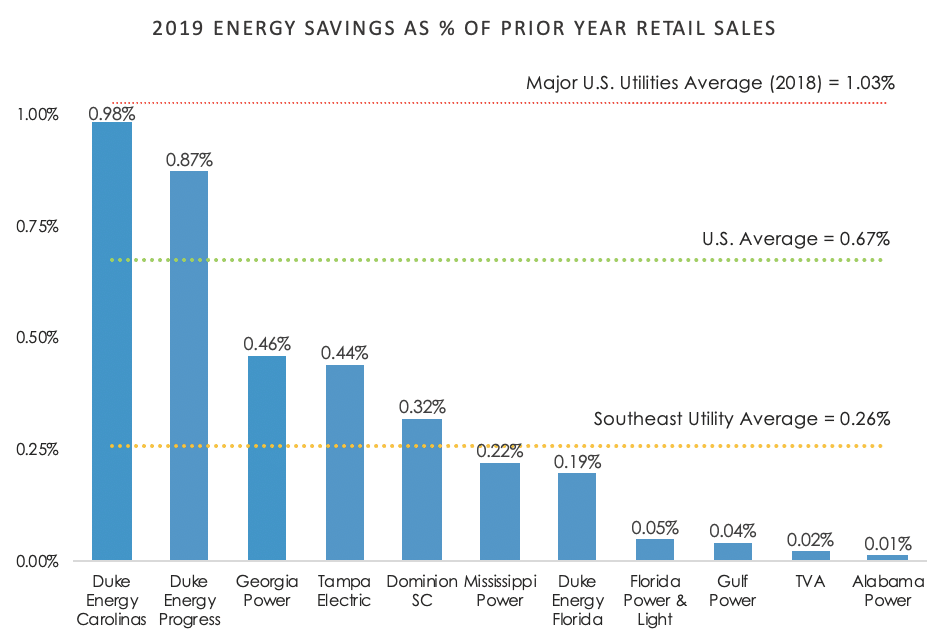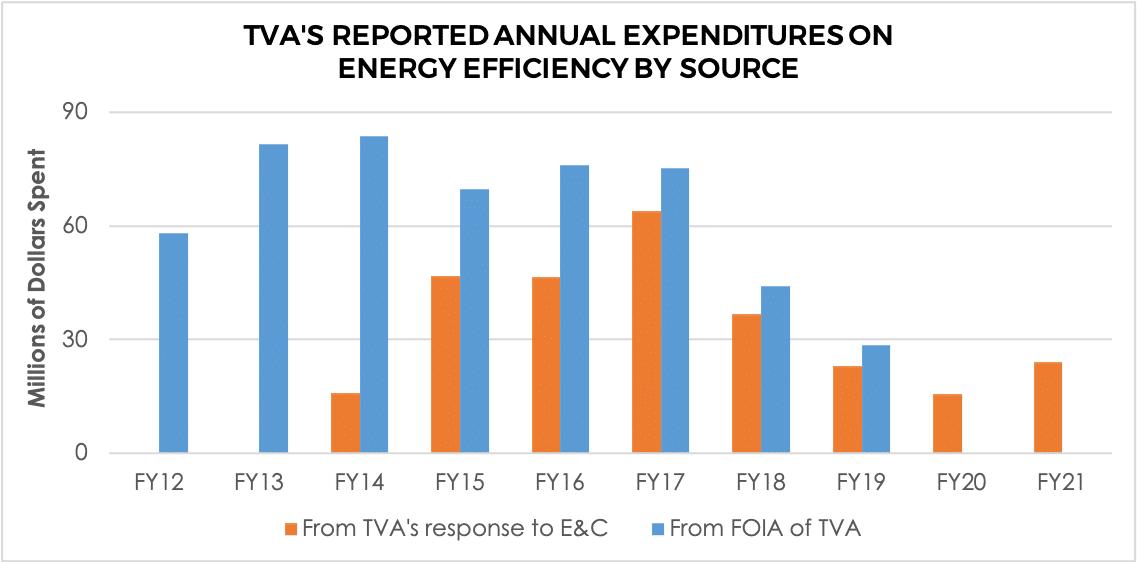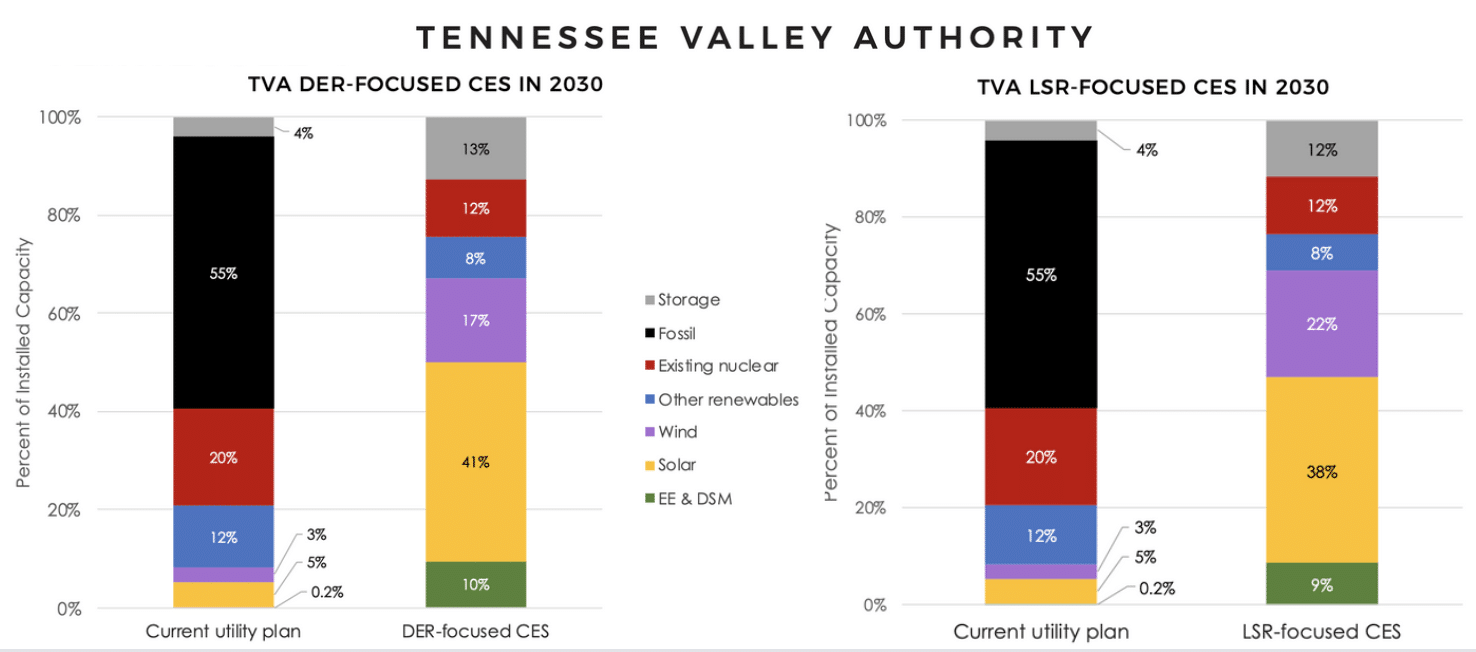TVA's response to the House Energy & Commerce Committee's oversight inquiry includes many outdated, misleading, and incomplete claims. We break down what is fact and what is fiction.
Maggie Shober | February 10, 2022 | Energy Efficiency, Energy Policy, Solar, Tennessee, UtilitiesOn January 13, 2022, the House Energy and Commerce Committee sent an oversight letter to the Tennessee Valley Authority “requesting information regarding [TVA’s] business practices and adherence to the Tennessee Valley Authority Act.” The letter asked important questions of TVA’s CEO Jeff Lyash, requesting a response by February 2. TVA’s response dodges several of the Committee members’ key questions.
Here we will take a deep dive through the questions and responses to provide clarity and context on TVA’s misleading claims and cherry-picked figures. The truth is, there are serious problems in how TVA is handling energy burdens, environmental justice, and its contributions to the climate crisis. Both the House Energy and Commerce Committee and the public have a right to know the truth, which TVA is clearly attempting to hide.
Energy Efficiency
In its letter to TVA, the House E&C inquiry clearly asks for clarity on how TVA’s approach to energy efficiency has changed, what prompted such a change, and how (if at all) the utility plans to use energy efficiency to address high electricity bills and the need to reduce reliance on fossil fuels.
TVA’s responses to the questions on energy efficiency are misleading, at best. TVA attempts to dismiss the Committee’s concerns about its pullback of energy efficiency by claiming utility energy efficiency programs are no longer needed because building codes and appliance standards have taken over as energy efficiency tools. This argument is problematic on many levels. As we at the Southern Alliance for Clean Energy (SACE) have stated many times, the improvement of codes and standards is an improvement to the baseline of efficient buildings and appliances that utilities have to work with, but better codes and standards do not reduce the customer benefits of the utility incentivizing customers to be more efficient than that baseline.

Utilities across the country face the same improvements to codes and standards, and most have been able to achieve energy savings through efficiency programs that put TVA’s to shame. Our previous analysis showed that in 2019 Duke Energy’s three Southeast utilities, which together are similar in size to TVA, achieved 36 times the amount of savings, and Duke’s savings are just at the national average. It is beyond obvious that TVA can and should be doing more on energy efficiency.

Low-income customers disproportionately live in older homes with older appliances. Without the financial means to purchase new homes and appliances, changes to building codes and appliance standards often do not benefit low-income households.
On the data side, TVA presents cumulative savings in response to a question from the Congressional inquiry that appears to be seeking information on the utilities annual efficiency savings, which is the standard metric used to track savings performance over time and to compare across different utilities. While TVA claims cumulative savings ranging from 0.9% to 1.5%, its annual efficiency savings since 2014 actually ranged from a high of 0.31% in 2014 down to 0.02% in 2019 – making TVA the second-lowest performing utilities in the south and among the worst of the worst in the nation.

Taking into account the fact that TVA’s load has declined in recent years, it is clear the amount of savings the utility can credit towards its efficiency programs each year has dropped substantially. But digging deeper, one sees TVA has employed a deceptive sleight of hand as it reports spending only for the programs it still operates, omitting the programs the company discontinued when it slashed efficiency budgets after FY17. This troubling fact can be seen clearly above by comparing the utility’s response to the Congressional inquiry to the answers TVA provided previously to a freedom of information act (FOIA) request filed by SACE. It would appear TVA only included only existing programs while omitting programs it has eliminated. Perhaps TVA only included existing programs so that the drop-off in its energy efficiency funding does not look as dramatic?

In its response to question five – Will TVA commit to deploying more energy efficiency in its next integrated resource plan (IRP)? – TVA does state it will commit to investing more in its energy efficiency programs as informed by the results of the Market Potential Study currently underway. We don’t know how much energy efficiency they are committing to, and there’s a lot of room to increase from near zero, but it’s something. Before that happens, TVA must stop using improved codes and standards as an excuse for gutting its energy efficiency programs, which are proven to lower customer bills, put downward pressure on rates, offset the need for expensive new fossil fuel infrastructure, and reduce pollution, including emissions that are worsening the climate crisis.
Distributed Solar and Rates
In its response to the inquiry from the E&C Committee, TVA does not deny that it adopted the Grid Access Charge (GAC), which acts as a fixed fee on utility customers and thus encourages local utilities to discourage their customers from installing solar, and was motivated by a desire to limit the amount of distributed solar installed in the region. TVA brings up the old boogeyman myth that distributed solar on homes and businesses shifts costs to customers without solar, and yet it doesn’t present any evidence of such a cost shift. That’s because there isn’t any, this cost shift has been disproven time and time again.

In addition, TVA angles its suppression of distributed solar as a way to protect those “who cannot afford DER [distributed energy resources, like rooftop solar].” Recent analysis shows most households that install solar are not the super-rich, and in fact, nearly half of all households that install solar have annual incomes of $100,000 or less and over 70% have annual incomes of $150,000 or less. This is a national trend, but it includes figures from states like California that have much higher median and average annual incomes. Unfortunately, we can’t cite income data for Tennesseeans that install solar because there were so few residential solar installations the sample size is too small to draw decent conclusions from. While households that install solar do tend to have higher incomes than regional medians, utilities across the country are implementing programs to make it easier for median and low-income households to install solar. Instead, TVA has made it harder by skewing rate structures to extend payback periods and putting barriers in place.
As part of the grid access charge response, TVA states that only 11 of 153 local utilities requested TVA’s approval to amend its fixed charge based on the GAC. However, TVA had already been encouraging local utilities to increase fixed fees before the GAC was even implemented. And local utilities may have increased fixed fees but did not inform TVA it was a direct response to the GAC. To better understand the implementation of the GAC at the local level, a database of fixed fees for each utility for the timeframe from 2014-today would be the best place to start.

The last piece on the GAC is that TVA basically admits the GAC failed to serve its purpose: disincentivizing distributed solar. However, TVA presents exactly zero evidence to back this up. It states “residential rates since October 2018 have had little to no change related to the GAC.” Any evidence? No. What does “little to no change” mean? How is TVA quantifying “related to the GAC?” Your guess is as good as mine. And then TVA states that because of the “little to no” rate change it “expects there has been essentially no or very limited impact on the adoption of distributed solar installations due to the rate change.” Again, any evidence? None. Even if the decrease was small, the E&C Committee asked for TVA to provide how distributed solar installations have decreased. And while we don’t have 2021 data yet, we can see from earlier data that distributed solar grew only 2% between 2019 and 2020 compared to 5% and higher in previous years. Our solar reports track that TVA was an early regional leader on distributed solar, but its distributed solar watts/customer fell below the regional average in 2019 and 2020.
TVA mentions two rate changes it has made since approving the GAC. One is to encourage the installation of electric vehicle (EV) charging infrastructure. SACE has worked with other utilities in the region to implement rate changes that can help companies deploy EV chargers in an efficient and equitable manner, and we are encouraged that TVA has taken a step in this direction. However, the other rate mentioned would allow local utilities to set up separate rates for customers that “self-supply some of their electric requirements.” This change was approved by the TVA Board at its August 2020 meeting and would allow local utilities to charge customers with solar higher fixed fees or mandatory minimum bills. Without any local utility examples, we can’t be sure what TVA’s true intentions were for this change.
One intention of the Public Utilities Regulatory Policy Act (PURPA) of 1978 was to improve the efficiency of electricity and stimulate a market for alternative and small generation sources. TVA provides the E&C Committee with links to its Dispersed Power Production Program, which it says complies with PURPA. While it technically may comply with the letter of the law, it misses the spirit by leaving small power projects no other option to provide power to TVA customers except through these terrible contract terms and unrealistically low prices.
Future Renewable Plans and Decarbonization
Laughably, when the E&C Committee asks TVA why it has underinvested in solar and wind, the utility retorts by claiming it is a leader in renewable generation by including its hydro resources in that mix. The E&C question does not use the term renewable but explicitly asks about wind and solar. We’ve been through TVA’s attempts to greenwash the solar in its 2019 IRP. The 2019 IRP does not put TVA on a trajectory for solar to “play a substantial role” as the utility claims. And TVA’s target of 10 GW of solar by 2035, while a step in the right direction, isn’t as ambitious as it sounds when compared to what is needed to truly reduce carbon emissions.

Our analysis of a few pathways TVA could take to get to a zero-carbon generation fleet includes between 25-30 GW of solar, both as distributed energy resources and large utility-scale projects. And while TVA talks about having contracted for 2,300 MW of solar, its annual report filed in November of 2021 states it had only 643 MW operating. I don’t see any reason to believe even TVA’s 10 GW plan has any teeth to it.
Decarbonization
It may seem like a joke if the subject were not so serious, but TVA claims in its response that its goal of 80% carbon reductions by 2035 is the same as the goal of 100% carbon reductions by 2035 laid out in President Biden’s Executive Order 14008. That is some seriously Orwellian math.
TVA claims it is continuing to explore ways TVA can accelerate its “emissions reduction journey,” and yet, as described above, it is eschewing tried-and-true technologies that reduce emissions and costs: energy efficiency and renewable energy. Paired with its existing fossil gas and hydro resources as well as new investments in energy storage, these are the ways to maintain a “safe, reliable, and low-cost power” for TVA customers. The solutions are there. They are so obvious. And TVA has thoroughly missed the point.
Fossil Gas
TVA claims fossil gas is needed to complement the “intermittency” of renewable generation sources like solar. It is true that solar is a variable resource, but it is predictable. Large amounts of solar do not go offline in an unpredictable way. What does? Large thermal power plants powered by gas, coal, or nuclear. If one of these plants goes down, it can be a big loss to the system. If many do, as we’ve seen can happen when the gas supply is constrained, it is very significant.
There is no denying that having some fossil gas generation on the system to even out the variability of renewables has its benefits. In fact, hydro can play a similar role as well. TVA already has 21% of its generation from gas and 10% from coal. That should be more than enough to smooth what little solar TVA has on its system and in its pipeline until it is able to deploy energy storage at scale. TVA has not shown, and it seems ridiculous to believe there is, a need for new gas in order to integrate solar. Look to the TVA’s neighbors, Duke Energy Progress and Duke Energy Carolinas. Combined these two Duke utilities had ten times as much solar operating in 2019 as TVA with less gas and less hydro. It is clear: TVA’s current level of gas is more than enough.

It is encouraging that TVA is “evaluating how best to incorporate [responsibly sourced gas] into its supply portfolio,” as stated in its response to the E&C inquiry. It could also take a step both Duke and Southern are taking to track the upstream methane emissions associated with its gas purchases.
Misuse of ratepayer funds
When responding to the E&C’s question about TVA’s funding of industry groups that are expressly set up to lobby and litigate against clean air and clean water regulations, TVA parroted what was already stated in the TVA inspector general’s report that the E&C question cites. These external groups that lobby and litigate on behalf of large investor-owned utilities include the infamous Utility Air Regulatory Group or UARG. TVA states that it is still in the process of implementing the recommendations of the inspector general’s report from October 2021, including that it is in the process of finalizing a contract with one of the external groups mentioned in the inspector general’s report. TVA goes on to say that it has a contract for “a broad range of legal services” with McGuire Woods, a law firm that now employees a number of high-profile UARG lawyers.
Next steps
The House E&C members and staff will review TVA’s response. If the response is deemed inadequate, the Committee members can issue another oversight letter or schedule an oversight hearing. We firmly believe TVA’s response warrants an oversight hearing, and have joined other clean energy and justice organizations to call for the Committee to hold one.